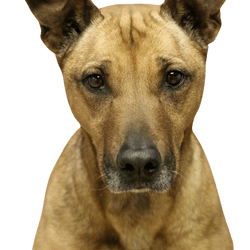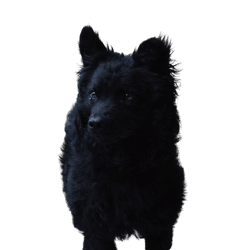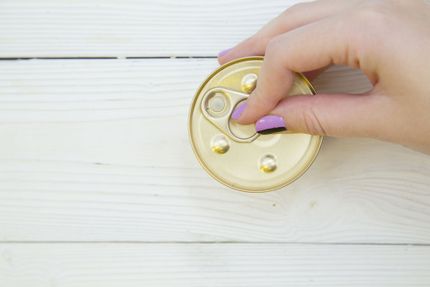
Miniature Pinscher Breed description: Character & Co
Miniature Pinscher
Facts & Origin
If you're thinking about buying a Miniature Pinscher, it is a good idea to get some information about this dog breed first. Miniature Pinscher puppies are best bought from a recognised breeder. Unfortunately, today you can often find small bred Mini- or Toy Pinschers being bred that weigh less than 4 kg and are often in poor health. If you would prefer a German Pinscher, which is a little bit bigger than the Mini Pinscher or a Pinscher cross breed,it is always an option too. But for now, to provide you with some more information, here are some interesting details about the Miniature Pinscher, which is also often called Dwarf Pinscher.
Originally, the Miniature Pinscher was bred for the hunting of rats and mice. The fast and agile little stable dog is still welcome on farms today because of their good-natured and loyal character, even if the Miniature Pinscher is now more frequently kept as a friendly companion dog and is appreciated because of its shiny coat.
What is the origin of the Dwarf Pinscher?
The Miniature Pinscher has its origin in Germany. In 1895, Josef Berta had the idea of separating rough-haired and smooth-haired dogs of a formerly common breed, which led to the rough-haired Schnauzer and the smooth-haired Pinscher being born. Today, there are six different Pinscher breeds, but only three of them look similar to each other and differ only in size, namely the Miniature Pinscher or Dwarf Pinscher, the German Pinscher and the Doberman. The Miniature Pinscher is the smallest of these three breeds.
What are the breed characteristics of the Miniature Pinscher?
Even though the Dwarf Pinscher is a particularly small breed among Pinschers, it is just as alert and persistent and protects its family and their property. Due to its size, this dog is particularly suitable as a city, residential or family dog.
The breed characteristics summed up once again:
- ideal city dog
- ideal house dog (but pay attention: still needs a lot of mental stimulation and exercise outside)
- family dog
- highly developed protective instinct
- small sized




| Alternate Name | Dwarf Pinscher, Miniature Pinscher , Min Pin |
| Origin | Germany |
| Life expectancy | 12 - 15 years |
| Care requirements | low-maintenance |
| Activity level | high |
| FCI group | Pinscher and Schnauzer type |
| AKC group | Toy Group |
| KC group | Toy Group |
Miniature Pinscher mixes
Attitude, character and temperament of the breed
What are the typical character traits of the Dwarf- or Red Miniature Pinscher?
The Dwarf Pinscher is a very good guardian, it is especially loyal, persistent and resistant. It is particularly spirited, lively, curious and likes to learn. Therefore, it is also very well suited for dog dancing or similar dog sports, which challenge them mentally and physically. The Dwarf Pinscher is very affectionate and also likes to play. Nevertheless, if you have children in the family, you have to consider that the children should treat the little dog with the respect needed and, when the dog demands it, you should leave it the possibility to retreat. If this is not provided, they might show resistance.
The character traits of the Dwarf Pinscher summed up once again:
-
alert
- loyal
- persevering
- resistant
- spirited
- lively
- curious
- eager to learn
- affectionate
- playful
Character
Usage
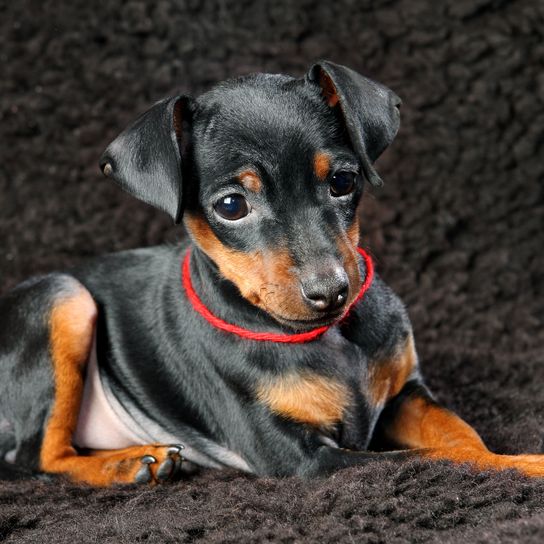



Health and breeding information
What are typical diseases of the Miniature Pinscher?
There are also two diseases that can occur in the Dwarf Pinscher, namely Acral Mutilation Syndrome, which is a congenital nervous disease, and Mucopolysaccharidosis, a metabolic disorder. In general, Dwarf Pinschers belong to the most robust and healthy breeds of dogs, but only if you pay attention to buying a dog that is more than 4 kg from a serious breeder, because the nowadays often very small bred Dwarf Pinschers are prone to developing many other diseases. This is important, if you want to buy a Dwarf Pinscher.
What should be considered when breeding Miniature Pinschers?
If you are thinking about breeding Dwarf Pinschers yourself, please make sure that the above mentioned hereditary diseases have not appeared in the bloodline of your breeding animals. And please also make sure that you only offer puppies that will later reach the normal and healthy weight of 4 to 6 kg when they reach adulthood. There are many fans of this dog breed at the moment and these puppies are in great demand.
In Austria, the Miniature Pinscher is also known as "Rehrattler". Rattlers were traditionally kept as stable dogs in Austria; they reliably kept mice and rats away from the Austrian stables.
Because of their short coat the Miniature Pinscher is the ideal companion for people with allergies. Like all dogs, the Miniature Pinscher does not live on meat alone. The healthy food of your Miniature Pinscher can contain 15 to 20 percent of various vegetables and some rice. When breeding Miniature Pinschers, you should not only provide a rich and healthy food for the mother animal and the puppies, but you should also make sure that the litter gets enough rest so that your Miniature Pinscher puppies can grow up healthy and happy! The best place to buy a Miniature Pinscher is a local breeder. Unfortunately, you can find many dubious suppliers of cheap torture breeds on the Internet. If you would like to buy a Miniature Pinscher, you have to pay a one-time fee of about 500 Euro. Every registered breeder of Dwarf Pinschers sets their own prices for the puppies.


Appearance and coat of the Dwarf Pinscher
The Dwarf Pinscher is very small, has a smooth, short coat and no undercoat. Their legs are relatively long, they have an expressive face and a pointed muzzle, often their ears stand up, but they can also be folded downwards. The tail is smooth-haired and naturally long, the formerly common docking has been forbidden for years now. There are Dwarf - or Red Miniature Pinschers in two different shades of colour, either uni-coloured from reddish to dark reddish brown or bi-coloured in black with red accents on the legs, muzzle, ears, chest and under the belly.
What is the average size of a Dwarf Pinscher?
The withers height of a purebred Miniature Pinscher is 25 to 30 cm.
How much does a Dwarf Pinscher weigh?
If a Dwarf Pinscher weighs between 4 and 6 kg, it has an appropriate weight and is neither too thin nor too thick. An unusually high weight can quickly lead to joint diseases in your Miniature Pinscher and put a lot of strain on the little dog's activity. A healthy Dwarf Pinscher should not weigh more than six kilograms. If your Miniature Pinscher weighs considerably more than 6 kilos, you can ask a vet for advice. Often, even just extending your daily walks minimally and adding in retrieving games can help your adult dog lose weight!
What is the average age of a Miniature Pinscher?
Like many small dog breeds, the Miniature Pinscher can also reach a high age. On average, this dog breed lives up to an age of at least 15 years, often times even more. So you will enjoy the company of your little dog friend for a long time. You can contribute to long lasting health of your Dwarf Pinscher if you pay attention to a low-fat diet from late puppy age on and offer your Dwarf Pinscher many opportunities to run outside. Before you buy a Miniature Pinscher, you should also be aware of the breed-specific characteristics of the small dogs.
| Fur length | short |
| Fur | flat coated |
| Ear shape | Standing Ears |
| Tail | lang |
| Anatomy | slim, sporty |
| Size ♀ | 25 - 30 cm |
| Weight ♀ | 4 - 4 kg |
| Size ♂ | 25 - 30 cm |
| Weight ♂ | 4 - 5 kg |
| Suitable For | Children |
Colors






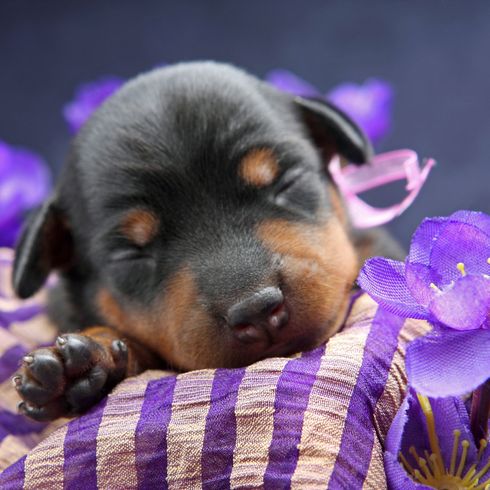
Known Diseases
Permanent tremor
Persistent tremors can be very common in small breeds, and are often psychological.
Nervousness
Very often, unfortunately, small and thin breed suffering from permanent nervousness.
FAQ
-
No, Miniature Pinschers are not considered a dangerous or aggressive dog breed.
-
High quality food is essential for the health of a Miniature Pinscher. You should calculate the amount of food on the age and weight. A rule of thumb says 2.5% of the weight is a good amount of food. So a 5kg Dwarf Pinscher should eat 125 grams per day.
-
Small dogs are often less educated and trained. Misbehaviour is ignored. A Miniature Pinscher is considered a barker if it has been trained badly or not at all. In principle, no dog is a barker by nature.
Other medium dogs
Useful Articles
You can find articles that might interest you in the dogbible blog to match your favorite breed.
Visit our magazineto stay up to date on dog trends.
To find out more, view our Privacy Policy
Find here the breed that suits you and find out what character traits it has. Here you can also learn more about the origin, size and weight of your favorite breeds.
Matching your favorite breed, you'll find articles that might interest you on the dogbible dog blog.
Atopy in dogs - causes, symptoms, diagnosis and treatment
First aid for dogs - everything you should know







